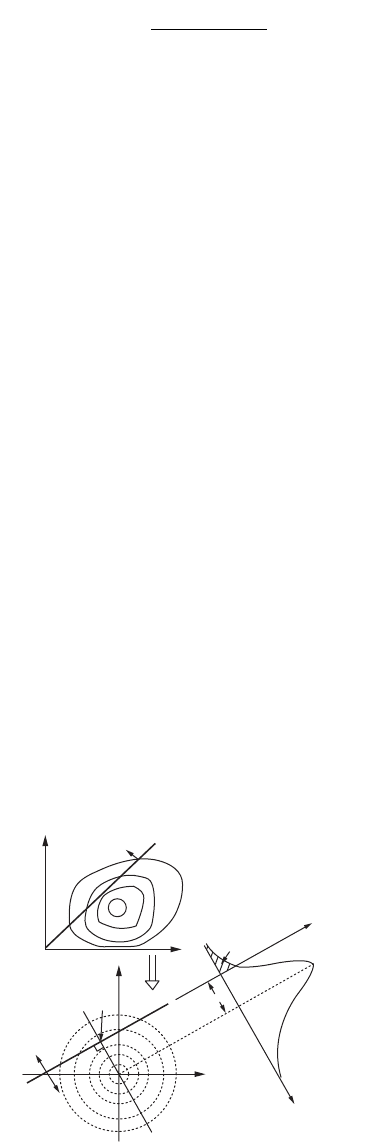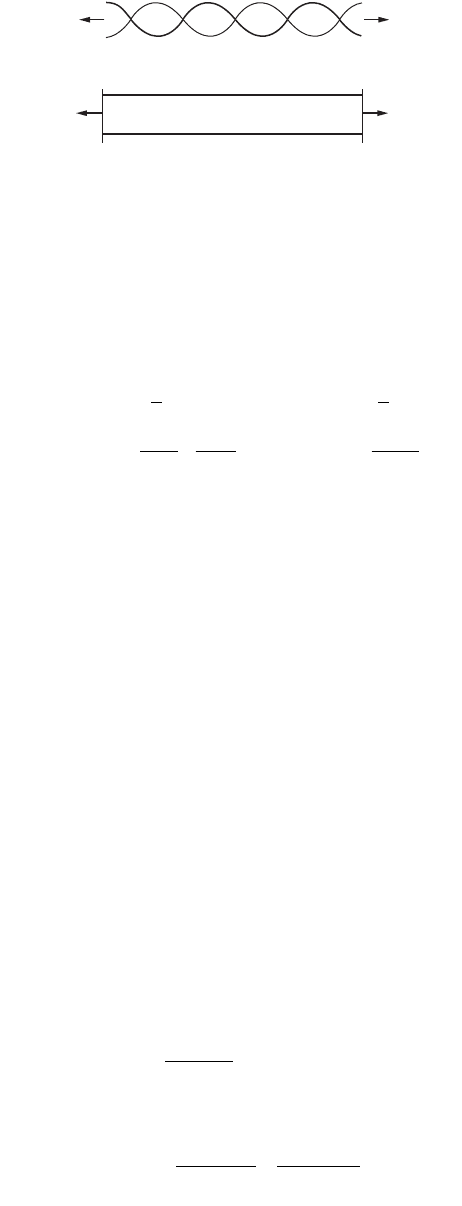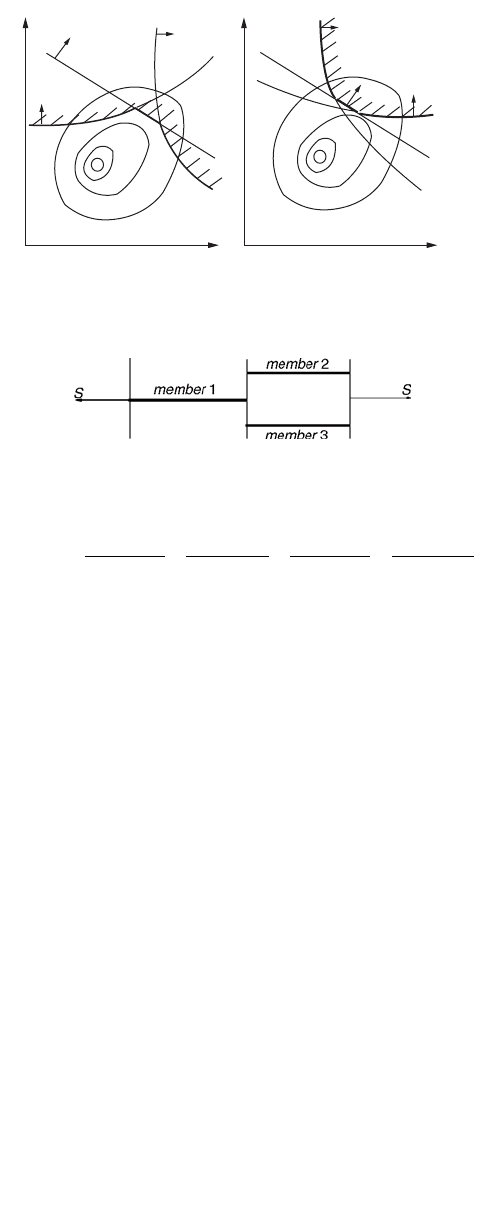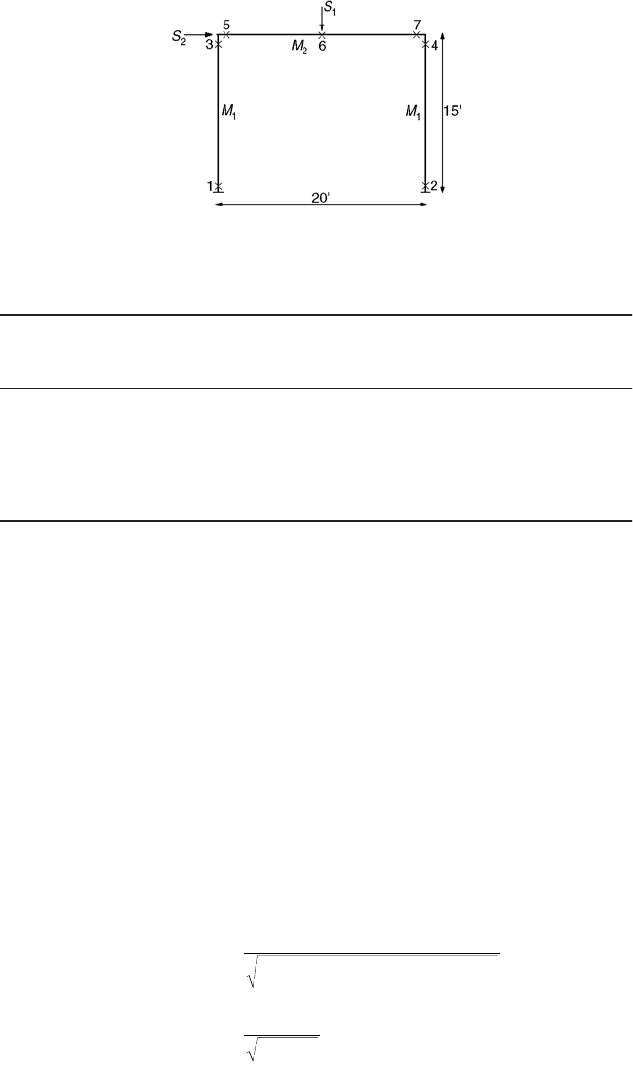Wai-Fah Chen.The Civil Engineering Handbook
Подождите немного. Документ загружается.


52-8 The Civil Engineering Handbook, Second Edition
An equivalent formulation is to define a performance function
(52.15)
In this case, M can be interpreted as the margin of safety, and g(R, S) is a limit state function. The
mean m
M
and standard deviation s
M
of M can be computed following Eqs. (52.8) and (52.9). If both R
and S are normally distributed, then M is also normally distributed. Equation (52.15) can then be
evaluated as
(52.16)
The quantity m
M
/s
M
is denoted as b and is known as the reliability index. Its relationship to the safety
margin in the probabilistic sense is illustrated in Fig. 52.4. Some b values in the practical range and their
corresponding failure probabilities with respect to the normal distribution are given in Table 52.3.
For the case where both R and S can be modeled more accurately by the lognormal distribution, the
factor of safety format will result in an easier computation of p
f
. That is, define the performance function
as
(52.17)
By taking the natural logarithm and in view of Eq. (52.3), Eq. (52.14) can be simplified as
(52.18)
FIGURE 52.4 Probabilistic interpretation of safety margin.
TABLE 52.3 Reliability Indices and
Corresponding Failure Probabilities
Reliability Index b Failure Probability p
f
10
–1
1.28
10
–2
2.33
10
–3
3.10
10
–4
3.72
10
–5
4.25
10
–6
4.75
Area =
p
f
m
f
M
(
m
)
bs
M
m
M
MgRS RS=
()
=-,
pPM
f
M
M
RS
RS RSRS
=£
()
=
-
Ê
Ë
Á
ˆ
¯
˜
=-
-
++
Ê
Ë
Á
Á
ˆ
¯
˜
˜
0
0
2
22
FF
m
s
mm
ss rss
MgRS RS=
()
=,
pPM
f
RS
RS RSRS
=£
()
=-
-
++
Ê
Ë
Á
Á
ˆ
¯
˜
˜
0
2
22
F
ll
zz r zz
ln ln
© 2003 by CRC Press LLC

Structural Reliability 52-9
where
for small V
R
and V
S
.
For problems involving n random variables, X = {X
1
, X
2
, X
3
, … X
n
}, with performance function
(52.19)
The mean and variance of M in Eq. (52.16) is computed as
(52.20)
First-Order Second-Moment Index
It should be mentioned here that in the early stage of the development of structural reliability theory, b
given in Eq. (52.16) is proposed as the first-order second-moment index, since only the first two moments
of the random variables are involved. The failure probability is approximated by Eq. (52.16), which is
exact if the random variables are normally distributed and g(X) is a linear function.
Hasofer–Lind Reliability Index
Consider the case where R and S are uncorrelated. Define the standardized form of the random variable
as R¢ = (R – m
R
)/s
R
and S¢ = (S – m
S
)/s
S
. The limit state function of Eq. (52.15) can be rewritten as
(52.21)
If the limit state function is plotted on the R¢ – S¢ coordinate system (see Fig. 52.5), then b is the
shortest distance from the origin to the limit state function g(R¢, S¢) = 0, also known as the Hasofer–Lind
reliability index. The point x* has the highest probability density value in the failure region and is hence
termed the most likely failure point.
FIGURE 52.5 Hasofer–Lind reliability index and most likely failure point.
r
r
zz
r
ln ln
ln
RS
RS R S
RS
RS
VV
=
+
()
@
1
Mg a aX
ii
i
n
=
()
=+
=
Â
X
0
1
mms rss
MiX
i
n
MijXXXX
j
n
i
n
aa aa
iijij
=+ =
===
ÂÂÂ
0
1
2
11
,
MgRS R S
RSRS
=
()
=
¢
-
¢
+-=, ssmm0
β
Marginal PDF
projected in
direction of
g
= 0
g
Transformed space
Safe
region
Failure
region
Most likely
failure point
x
*
R
p
f
S
′
R
′
S
Original space
R
<
S
or
g
< 0
g
(
R
,
S
) =
R
−
S
= 0
© 2003 by CRC Press LLC

52-10 The Civil Engineering Handbook, Second Edition
Another important set of information that can be extracted from this computation is the sensitivity
of each random variable to the reliability index. This is given by the direction cosines, which for this
example is
(52.22)
The most likely failure point in the transformed coordinate space is given by
(52.23)
Reliability Estimate by FORM
In general, the limit state function can be nonlinear and the distribution of the random variables different
from normal or lognormal. The first-order reliability method (FORM) has been developed to evaluate
the failure probability with reasonable accuracy and cost for realistic structures. The basic idea of the
method can be summarized as follows:
1. For the general case of correlated nonnormal random variables, the Rosenblatt transformation can
be employed and requires the complete joint PDF (see, e.g., Ditlevsen and Madsen, 1996). In many
practical problems, only the marginal distribution functions and the covariance matrix are known.
For such cases, approximations using the Nataf distribution can be employed (Der Kiureghian
and Liu, 1986). A more approximate but simpler procedure and its variations have been developed.
Essentially, the random variables are first transformed into uncorrelated random variables using
the correlation matrix (basically finding its eigenvalues and eigenvectors). The principle of normal
tail approximation (Rackwitz and Fiessler, 1978) is then employed to replace the nonnormal
distributions by normal distributions. For the latter, the equivalent normal distribution parameters
are determined such that the PDF as well as the CDF values at the most likely failure point
corresponding to the actual and the normal distributions are equal.
2. The nonlinear performance function, g
NL
(X), is linearized at the most likely failure point (denoted
as X*) in the standardized normal coordinate space. That is, g
NL
(X) is now approximated by
Eq. (52.19) with a
i
given by the partial differential ∂g
NL
(X)/∂X
i
evaluated at X*. This is basically a
first-order Taylor series expansion of the nonlinear performance function. Since X* is not known
apriori, an iterative solution to obtain b is inevitable.
Based on the principle of normal tail approximation and the first-order approximation of g
NL
(X)
described above, a simple algorithm to compute b is given by the following steps:
1. Find the eigenvalues l and corresponding eigenvectors T corresponding to the correlation matrix
r
XX
.
2. Assume an initial guess x* for X, satisfying g
NL
(x*) = 0. This can be achieved by using the mean
values for n-1 random variables, with the value for the remaining variable obtained by enforcing
the condition g
NL
(x*) = 0. Next, compute ∂g
NL
(X)/∂X
i
at x*.
3. For each of the nonnormal random variables, say with CDF F
X
i
(x) and PDF f
X
i
(x), compute the
equivalent normal parameters as follows:
(52.24)
a
s
ss
a
s
ss
R
R
RS
S
S
RS
=
+
=
-
+
¢
22 22
,
¢¢
()
=- -
()
()
=- -
()
rs rs
RS RRRSSS
**
**
,, , ,ab ab m abs m a bs or
sf
ms
X
N
Xi
Xi
X
N
iX
N
Xi
i
i
i
iii
fx
Fx
xFx
=
()
()
()
È
Î
Í
˘
˚
˙
=-
()
()
È
Î
Í
˘
˚
˙
-
-
1
1
1
*
*
**
F
F
© 2003 by CRC Press LLC

Structural Reliability 52-11
The values for the vector of reduced variates z
*
at the failure point can be obtained where
4. The reliability index, corresponding to the most likely failure point, can be computed using the
formula
(52.25)
where the superscript t denotes transpose.
5. The sensitivity factors can be estimated as
(52.26)
6. A new set of n-1 random variables can be formulated as
(52.27)
7. and x
n
*obtained by enforcing the condition g
NL
(x*) = 0.
8. Steps 3 to 6 are repeated until b and x* converge. The failure probability is then approximated by
p
f
= F(–b).
Reliability Estimate by Monte Carlo Simulation
The computation of failure probability is equivalent to evaluating the integral
(52.28)
where I[.] is a function taking a value of 1 if the condition in the bracket is true, and is assigned zero
otherwise. Analytical solution or even numerical integration using quadrature-based techniques is only
possible for limited cases. Hence, approximate numerical techniques such as FORM or higher order methods
(e.g., second-order reliability method (SORM)) have been developed. Alternatively, numerical integration
can be performed using Monte Carlo simulation (MCS) techniques. A brief introduction will be given here.
The generation of random numbers can be found in standard textbooks and will not be discussed here.
In essence, MCS involves the random generation of many realizations of a set of random variables,
say N realizations, and to count how many of these result in the condition g(X) £ 0. The failure probability
is estimated as
(52.29)
The variance of this estimate can be approximated by (Melchers, 1999)
(52.30)
b
l
r
s=
{}
=-
∂
()
∂
GT z
GG
X
t
t
XX
12
where G
g
X
iX
N
NL
i
x
i
*
b
l
r
s=
{}
=-
∂
()
∂
GT z
GG
X
t
t
XX
12
where G
g
X
iX
N
NL
i
x
i
*
a
l
r
=
12
TG
GG
t
t
XX
x
iX
N
iX
N
ii
*
=-mabs
pfdxIgfd
f
g
=º
()
=º
()
£
[]
()
ÚÚ ÚÚ
()
£
X
X
X
XXxx
0
0
p
N
Ig
fi
i
N
=
()
£
[]
=
Â
1
0
1
x
s
NN
Ig
N
Ig
pi
i
N
i
i
N
f
22
11
2
1
1
1
0
1
0=
-
()
()
£
[]
È
Î
Í
Í
˘
˚
˙
˙
-
()
£
[]
È
Î
Í
Í
˘
˚
˙
˙
Ê
Ë
Á
Á
ˆ
¯
˜
˜
==
ÂÂ
xx
© 2003 by CRC Press LLC

52-12 The Civil Engineering Handbook, Second Edition
From Eq. (52.29), it is obvious that when p
f
is small, N has
to be very large to get a reasonable estimate, which makes
MCS unattractive. This limitation can be further com-
pounded by cases where the dimension of X is large or g(X)
is not easy to evaluate (such as the need to perform a finite
element computation). In addition, the variance decreases
slowly with N. By using additional information to focus the
simulation on a more fruitful region, N can be made small
and the variance can be significantly reduced. Among the
many variance reduction techniques, the importance sampling
technique is currently one of the most popular in structural
reliability and is briefly described below.
The region that contributes most to p
f
is around the most
likely failure point x*. Hence, one can selectively generate the realizations around this vicinity. For example,
one can sample from distributions that follow f
X
(x), but with their means shifted to x*, denoted as h
X
(x),
as proposed by Harbitz (1983). This will result in having an order of N/2 points in the failure region (see
Fig. 52.6) and should logically reduce the size of N needed, subjected to some conditions being satisfied,
such as the nature of the performance function and the suitable choice of h
X
(x). Equation (52.29), in view
of the modified sampling space, becomes
(52.31)
The optimal choice of h
X
(x) is by no means simple and is the subject of many research papers that
cannot be adequately discussed in this brief introduction. Nevertheless, the following points should be
noted (Melchers, 1991):
1. h
X
(x) should not be too flat or skewed. As such, the use of normal distribution has been suggested.
2. x* may not be unique. The use of multiple h
X
(x) functions with corresponding weights may be
necessary.
3. A highly concave limit state function gives rise to low efficiency, and N may need to be large for
such cases. This may be overcome by using multiple h
X
(x) functions.
52.4 Systems Reliability
Structural engineering design, for the sake of simplicity, is invariably based on satisfying various indi-
vidual limit state functions. Similarly, a structure is usually designed on member basis, although its
optimal performance as an entire structure is desired. Codified optimal design at the structural systems
level has been the subject of research for many decades. Classical systems reliability concepts have been
employed in various applications, such as nuclear power plants, offshore installations, and bridges. In
view of space limitations, only issues closely related to structures will be briefly discussed in this section.
A general treatment of systems reliability pertaining to civil engineering can be found in Ang and Tang
(1984), whereas that pertaining to structures is fairly well treated by Melchers (1999).
Systems in Structural Reliability Context
Structural reliability problems involving more than one limit state are solved using systems reliability
concepts. Hence, in a general sense, a structural system can comprise only one element, such as a beam
FIGURE 52.6 Concept of importance sam-
pling in MCS.
X
2
X
1
Contours
of
f
x
(
x
)
Contours
of
h
x
(
x
)
Failure
region
Safe
region
Most likely
failure point
x
*
pIg
f
h
hdx
N
Ig
f
h
f
i
i
N
i
i
=º
()
£
[]
()
()
()
@
()
£
[]
()
()
ÚÚ
Â
=
X
x
x
x
x
x
x
X
X
X
X
X
0
1
0
1
© 2003 by CRC Press LLC

Structural Reliability 52-13
that involves combined stresses and deflection limit states, or can comprise many elements, as in a truss
or frame structure.
As an illustration, consider a simply supported beam of length l and stiffness EI subjected to a uniform
load w per unit length and designed with flexural capacity M
u
and shear capacity V
u
that must satisfy a
deflection limit D. The limit state equations can be written as follows:
(52.32)
The nonperformance or failure of this system happens when any one of the limit state equations is
violated. The failure probability can be formulated as
(52.33)
where the symbol » is the Boolean or operator to denote the union of events. For example, A » B denotes
the occurrence of event A, event B, or both events A and B. Such a system is known as a series system.
Another class of systems is the parallel system. Consider a simple redundant system comprising a
bundle of two steel strands with capacity R
1
and R
2
under a load S, schematically shown in Fig. 52.7.
Assume the capacities to be random but correlated with a coefficient denoted as r
R
1
R
2
. The failure
probability of this system can be written as
(52.34)
where the symbol « is the Boolean and operator to denote the intersection of events. For example, A «
B denotes the occurrence both events A and B. Such a system is known as a parallel system.
The failure region corresponding to the two different systems described by Eqs. (52.33) and (52.34) is
best illustrated assuming that there are only two random variables shown in Fig. 52.8. It should be noted
that even for cases where the individual g
i
(X) are linear, the failure region is bounded by piecewise linear
boundaries. Hence, the evaluation of Eqs. (52.33) and (52.34) is nonlinear and can be quite formidable.
Note that an equivalent form of Eq. (52.34) can be written by considering the complementary events,
such as g
1
(X) > 0, which is also denoted as , where the overbar indicates the complementary of
the event under the bar. Since the nonfailure of the two-strand structure implies the nonfailure of at
least one strand, one can write
(52.35)
FIGURE 52.7 Model of a two-strand parallel structure.
S
R
1
R
2
S
Two-strands rope
Structural model
SS
gMwl gVwl
g
wl
M
wM
V
g
wl
EI
uu
u
u
u
1
2
2
3
2
2
4
4
1
8
1
2
1
82
5
384
XX
XX
()
=-
()
=-
()
=- +
Ê
Ë
Á
ˆ
¯
˜
()
=-
,,
, D
pPg g g g
fe
=
()
£
()
»
()
£
()
»
()
£
()
»
()
£
()
[]
12 4
0000XXXX
pPg g
gRS gRS
f
=
()
£
()
«
()
£
()
[]
()
=-
()
=-
12
11 2 2
00XX
XX,
g
1
0()X £
pPg g
f
=-
()
£
()
»
()
£
()
È
Î
Í
˘
˚
˙
100
12
XX
© 2003 by CRC Press LLC

52-14 The Civil Engineering Handbook, Second Edition
Based on the same consideration, the equivalence of Eq. (52.33) is
(52.36)
The equivalence of the two sets of formulation is basically an application of De Morgan’s rule in set
theory.
In general, a complete system may be cast as a combination of parallel and series subsystems. For
example, consider the three-bar system shown in Fig. 52.9. Denote F
i
, i = 1, 2, and 3, as the failure of
members 1, 2, and 3, respectively. The system cannot withstand the load if member 1 fails or if both
members 2 and 3 fail. Thus, the probability of failure of the system can be formulated as
(52.37)
The evaluation of equations such as Eq. (52.37) can be a formidable task, and numerical techniques
need to be used. As an alternative, first-order and second-order bounds are often computed instead. The
bounds for the series and the parallel systems will be considered next, namely,
(52.38)
(52.39)
First-Order Probability Bounds
One extreme case is to consider all the events in Eq. (52.39) to be mutually independent. Hence, by virtue
of Eq. (52.12), Eq. (52.39) becomes
(52.40)
FIGURE 52.8 Failure region for system involving (a) union and (b) intersection of events.
FIGURE 52.9 Model of a simple series–parallel three-bar system.
(a) Failure region for union (b) Failure region for intersection
FAILURE REGION
FAILURE
REGION
SAFE REGION
SAFE REGION
X
1
X
2
X
2
X
1
g
2
(
X
) < 0
g
2
(
X
) < 0
g
1
(
X
) < 0
g
1
(
X
) < 0
g
3
(
X
) < 0
g
4
(
X
) < 0
pPg g gg
f
=-
()
£
()
«
()
£
()
«
()
£
()
«
()
£
()
È
Î
Í
˘
˚
˙
10000
1212
XXXX
pPF FF
f
=»«
()
[]
123
pPGGG G
n»
=»»»º»
[]
123
pPGGG G
n«
=«««º«
[]
123
pPGG GPGPGPG PG
indp n n i
i
n
«
=
=««º«
()
=
()()
º
()
=
()
’
12 1 2
1
© 2003 by CRC Press LLC

Structural Reliability 52-15
Similarly, Eq. (52.39) for mutually independent events is simplified as
(52.41)
Note that if P(G
i
) is small, as in most practical structural systems, then
The other extreme is when the G
i
are perfect-positively correlated. The corresponding probabilities are
(52.42)
Based on the above, the first-order probability bounds can be summarized as:
(52.43)
(52.44)
Second-Order Probability Bounds
The probability bounds given by Eqs. (52.43) and (52.44) for some applications can be wide and have
limited use. Hence, second-order bounds have been proposed where the joint probability of two events
P(G
i
G
j
) are used in the computation. The probability bounds for the union of events is given by
(52.45)
where the events G
i
are ordered in terms of decreasing probability, as a rule of thumb, for optimal results.
The joint probability of two events can be estimated either by numerical integration or by the following
approximate bounds:
pPGGG PG
PG PG
indp n i
i
n
i
i
n
i
i
n
»
=
=
=
=- « «º«
()
=-
()
=- -
()
[]
£
()
’
’
Â
11
11
12
1
1
1
pPG
indp i
i
n
»
=
ª
()
Â
1
.
pPGp PG
ppc
i
n
i ppc
i
n
i«
=
»
=
=
()
=
()
min max
11
and
max
min ,
i
n
i
i
n
ii
i
n
i
i
n
i
n
ii
i
n
PG P G PG
PG P G PG
=
-
=
=
-
=
()
£»
Ê
Ë
Á
ˆ
¯
˜
£- -
()
[]
≥
--
()
[]
£»
Ê
Ë
Á
ˆ
¯
˜
£
()
È
Î
Í
Í
˘
˚
˙
˙
£
’
’
Â
1
1
1
1
1
1
11 0
11 1 0
for
for
r
r
PG P G PG
PG PG
i
i
n
i
n
i
i
n
i
i
n
ii
i
n
()
£«
Ê
Ë
Á
ˆ
¯
˜
£
()
≥
£«
Ê
Ë
Á
ˆ
¯
˜
£
()
£
=
-=
-
=
’
’
1
11
1
1
0
00
min for
for
r
r
PG PG PGG
PG PG PG PGG
i
n
ii
i
n
ji
ij
i
n
i
n
iiij
j
i
i
n
»
Ê
Ë
Á
ˆ
¯
˜
£
()
-
()
È
Î
Í
Í
˘
˚
˙
˙
»
Ê
Ë
Á
ˆ
¯
˜
≥
()
+
()
-
()
È
Î
Í
Í
˘
˚
˙
˙
-
=
<
=
-
=
-
=
ÂÂ
ÂÂ
1
12
1
1
1
1
2
1
0
min , max
max ,
© 2003 by CRC Press LLC

52-16 The Civil Engineering Handbook, Second Edition
(52.46)
where
(52.47)
in which b
i
is the reliability index corresponding to P(G
i
£ 0) and r
ij
is the correlation coefficient between
G
i
and G
j
. An estimate of the latter is given by
(52.48)
where a
ik
are the components of the direction cosines aa
aa
at the most likely failure point corresponding
to G
i
, given in Eq. (52.26), with n as the number of basic random variables.
For tighter bounds, the use of higher order probabilities has been proposed (e.g., Greig, 1992). This
will not be treated here.
Monte Carlo Solution
The concept of MCS in estimating the failure probability for the case of a single limit state function
described earlier can be extended directly to that for series and parallel systems. For example, the indicator
function in Eqs. (52.28) and (52.31) for series system becomes
(52.49)
The difference in the application of importance sampling technique in this case is that the presence
of numerous limit state functions (see Fig. 52.8) complicates the choice of h
x
(x). A simple solution is to
consider a multimodal sampling function given by
(52.50)
and h
xi
(x) is the sampling distribution determined based on the ith limit state function and w
i
is the
weight, which is inversely proportional to b
i
.
Applications to Structural Systems
Design codes generally try to ensure that actual structural systems fail in ductile modes rather than brittle
ones. It is therefore reasonable to assume that the commonly used rigid-plastic model provides a rea-
sonable approximation to structural system behavior (Bjerager, 1984). The dependence of the probability
of failure on the load path for such a case is not a significant issue. On the other extreme, there are cases
where the actual member behavior can be better idealized as elastic-brittle, where within a structural
max ,
min ,
PA PB PGG PA PB
PGG PA PB
ij
ij
() ()
[]
£
()
£
()
+
()
≥
£
()
£
() ()
[]
£
for
for
r
r
0
00
PA PB
i
jiji
ij
j
iijj
ij
()
=-
()
-
-
-
Ê
Ë
Á
Á
ˆ
¯
˜
˜
()
=-
()
-
-
-
Ê
Ë
Á
Á
ˆ
¯
˜
˜
FF FFb
brb
r
b
brb
r11
22
,
raa aa
ij ik jk
k
n
ik
k
n
jk
k
n
=
Ê
Ë
Á
Á
ˆ
¯
˜
˜
Ê
Ë
Á
Á
ˆ
¯
˜
˜
===
ÂÂÂ
1
2
1
2
1
Igx I
i
n
i
»
()
<
È
Î
Í
˘
˚
˙
=
[]
=
=1
01
0
if is true
otherwise
.
hx wh x w
XiXi
i
n
i
i
n
()
=
()
=
==
ÂÂ
11
1 where
© 2003 by CRC Press LLC

Structural Reliability 52-17
system, deformation at zero capacity is possible after the peak capacity has been reached (Quek and Ang,
1986). Real structures will behave somewhat in between these two idealized models and can be too
complex for accurate evaluation of the system failure probability. Consequently, one can consider prob-
abilistic upper and lower bound solutions.
For structures that ultimately fail in a ductile manner, the collapse mechanism approach can be
employed. As an illustration, consider a simple one-story one-bay frame under concentrated vertical and
lateral loads, as shown in Fig. 52.10, with the seven critical sections marked and numbered (Ma and Ang,
1981). The member plastic moment capacities, M
1
and M
2
, have mean values of 360 and 480 ft-kips with
standard deviations of 54 and 72 ft-kips, respectively. The loads, S
1
and S
2
, have mean values of 100 and
50 kips with standard deviations of 10 and 15 kips, respectively. All four random variables are assumed
to be independent normal variates. Six physically admissible mechanisms can be generated, with the limit
state function corresponding to each given in Table 52.4.
The reliability index and failure probability of each individual performance function can be obtained
using Eqs. (52.16) and (52.20) and Table 52.2. For example,
To find the first-order probability bounds, Eq. (52.43) gives 0.03463 £ p
f
£ 0.06124.
To obtain the second-order bounds, the joint probability of pairs of events is needed. It is illustrated
using G
1
and G
2
. First, the correlation coefficient is computed using Eq. (52.48). The a values for G
1
and
G
2
are (0.6037, 0.4025, –0.2795, and –0.6289) and (0.6925, 0, 0, and –0.7214), respectively. Hence, r
2
=
0.8718. From Eq. (52.47),
FIGURE 52.10 Simple frame structure with potential plastic hinges (numbered 1 to 7).
TABLE 52.4
Mechanisms, Performance Functions, and Failure Probabilities
Mechanism
i
Location
of Hinges
Performance
Functions
G
i
Reliability Index
b
i
Failure
Probability
p
fi
11, 2, 3, 6 4M
1
+ 2M
2
– 10S
1
– 15S
2
1.8167 0.03463
21, 2, 3, 4 4M
1
– 15S
2
2.2123 0.01347
31, 2, 5, 6 2M
1
+ 4M
2
– 10S
1
– 15S
2
2.2589 0.01195
45, 6, 74M
2
– 10S
1
3.0177 0.00127
51, 2, 5, 7 2M
1
+ 2M
2
– 15S
2
3.2276 0.00062
63, 4, 62M
1
+ 2M
2
– 10S
1
3.3024 0.00048
PG
MM S S
MM S S
1
22 2 2
0
421015
16 4 100 225
650
128 017
1 8167 0 03463
12 1 2
12 1 2
£
()
=-
+--
++ +
Ê
Ë
Á
Á
ˆ
¯
˜
˜
=-
Ê
Ë
Á
ˆ
¯
˜
=-
()
=
F
FF
mm mm
ss s s
,
..
© 2003 by CRC Press LLC
